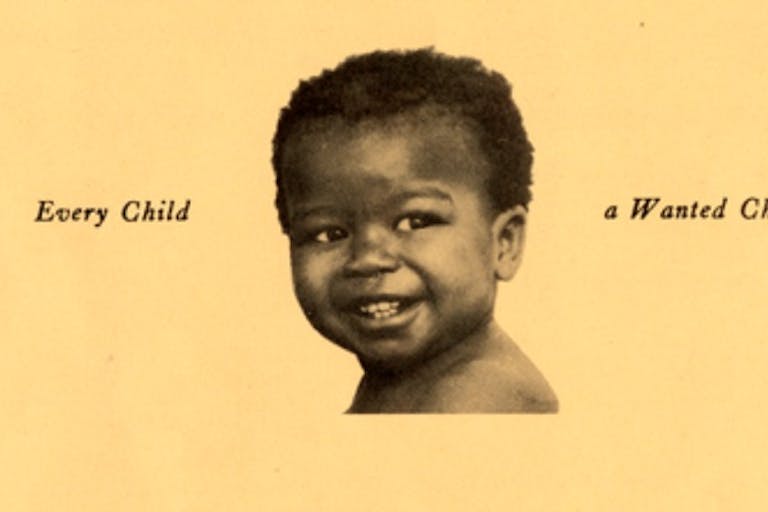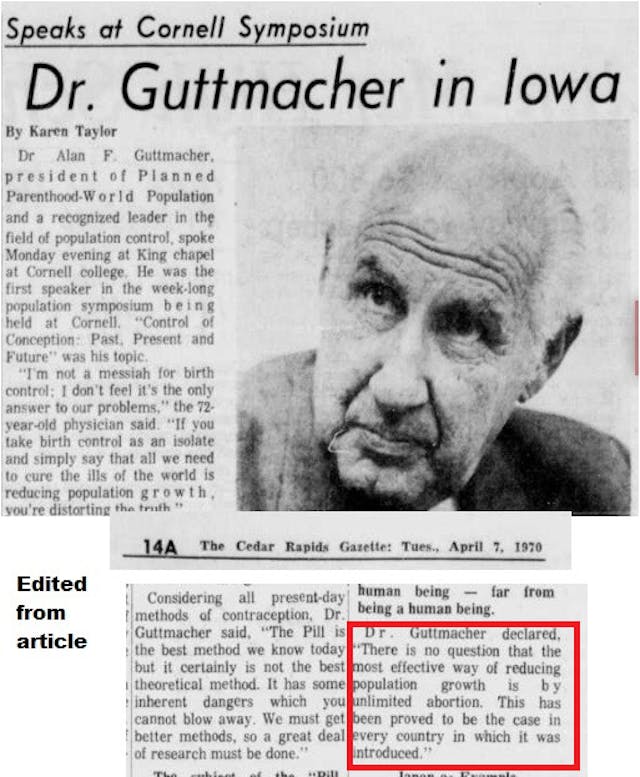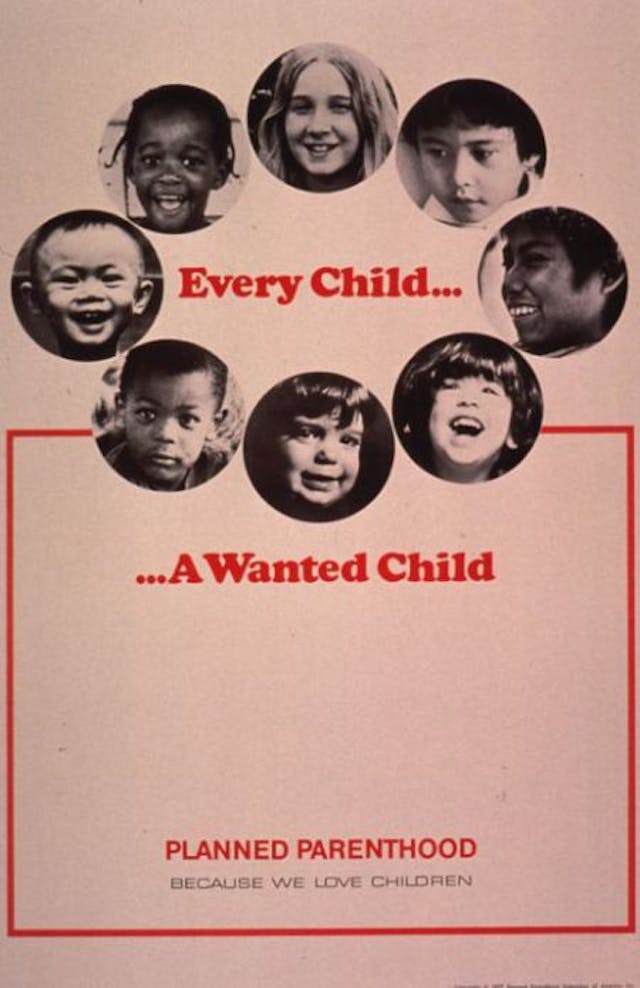
Who has most abortions? The data may (or may not) surprise you
Carole Novielli
·
Get the facts: Abortion has always been about controlling certain populations
The call for legalizing abortion in the United States was not due to women demanding it — the call came from eugenicist zealots pushing abortion as a population control solution.
In a 2009 New York Times Magazine interview with now-deceased Supreme Court Justice Ruth Bader Ginsberg suggested that Roe was a product of eugenic philosophy meant to limit certain populations. She shockingly acknowledged, “I had thought that at the time Roe was decided, there was concern about population growth, and particularly growth in populations that we don’t want to have too many of.”
In 1969, Harriet Pilpel, general counsel to the American Civil Liberties Union — and later, chairwoman of the Law Panel International of Planned Parenthood Federation, according to the New York Times — published The Right to Abortion, in which she described abortion as “the most widespread… method of fertility control in the modern world,” adding, “If we really want to cut our population growth rate on a voluntary basis, we should make abortion available on a voluntary basis, at least in the early stages of pregnancy.”
Abortion enthusiasts were very concerned about population control, with some promoting coercive measures to control population growth. Among them were Alan F. Guttmacher, the impetus behind Planned Parenthood’s decision to commit abortions, and Lawrence (Larry) Lader, a former co-founder of NARAL Pro-Choice America (known then as National Association for the Repeal of Abortion Laws) who was dubbed the “father of the abortion movement.”
The 1969 New York Times article, “Dr. Guttmacher is the Evangelist of Birth Control,” acknowledges that many leaders sitting on Planned Parenthood’s board were in favor of coercive measures of population control. The Times also noted that a “sizable” number of Planned Parenthood’s board was made up of “preponderantly white and well-to-do” people, and quoted a Planned Parenthood board member who admitted that a racist attitude pervades the organization. He stated, “What it all comes down to is that we want the poor to stop breeding while we retain our freedom to have large families. It’s strictly a class point of view.”
In 1966, Guttmacher compared the idea of overpopulation with the threat of nuclear war, telling the Washington Post that governments may need to take population control measures among families “out of the voluntary category.” But, while many openly espoused the use of coercion, Guttmacher also suggested “volunteerism” as a better strategy to the same end and claimed it was “strategically unwise” to promote coercion at that time. But he never ruled out coercive measures, instead indicating that if voluntary means did not bring population numbers down, some form of coercion would become necessary.
While Guttmacher and Margaret Sanger, both eugenicists, were concerned that overpopulation was a threat, it was under Guttmacher’s leadership that Planned Parenthood first voiced the idea of abortion as part of the ‘solution’ to this perceived problem.
He said in a 1970 interview, “If we could get the abortion law liberalized, most of the 750,000 unwanted pregnancies would not lead to babies – rejected children, battered baby syndrome and illegal abortions.” That same year, Guttmacher admitted to a Cornell Symposium, “There is no question that the most effective way of reducing population growth is by unlimited abortion.”

Sue Ellen Browder points out in her book, “Subverted,” that Larry Lader was also concerned about overpopulation. This was attributed to the influence of Dixie Cup founder Hugh Moore, who called overpopulation “the greatest threat to world peace.”
Lader was a biographer and admirer of Margaret Sanger. But while Sanger openly used eugenic terms, Lader was more subtle, claiming that society should be responsible for the “protection of the child and its future.” But Lader was really referring to the future of the elites, the perfect, and the mostly Caucasian — not to every child.
In 1966, Lader authored the book “Abortion” in which he stressed, “We will only defeat ourselves by producing an endless cycle of unwanted children. Those born in slums, for example, denied even the smallest share of education and economic opportunity, have little chance of realizing their full potential as citizens.”
Lader went on to quote Garrett Hardin, a leading eugenic ecologist who was a co-founder of NARAL with Lader: “When unwanted children become parents they are more likely than others to be poor parents themselves and breed another generation of unwanted children. This is a vicious cycle if there ever was one. It is ruinous to the social system.”
Article continues below
Dear Reader,
In 2026, Live Action is heading straight where the battle is fiercest: college campuses.
We have a bold initiative to establish 100 Live Action campus chapters within the next year, and your partnership will make it a success!
Your support today will help train and equip young leaders, bring Live Action’s educational content into academic environments, host on-campus events and debates, and empower students to challenge the pro-abortion status quo with truth and compassion.
Invest in pro-life grassroots outreach and cultural formation with your DOUBLED year-end gift!
“As long as a reasonable chance of contraceptive failure persists, however, abortion must be included as part of birth control to insure every child’s becoming a wanted child,” Lader wrote.
“Every child a wanted child” eventually became Planned Parenthood’s motto, a phrase likely coined by another eugenicist, Frederick Henry Osborn, who once wrote, “Birth control and abortion are turning out to be great eugenic advances of our time.”

This false motto was also touted by Guttmacher in a 1968 interview which reportedly originated from WLBC-TV (see below) where he stated, “Planned Parenthood is relatively simple to define. It is a movement which tries to make each child a wanted child born into responsible parents. This is only possible if the parents plan their parenthood.”
Guttmacher went on to address population increases. “Now, I think everyone is conscious of the fact that in some areas of the world there is explosive type of population increase, unsupportable, in that it is outdistancing food, it retards economic development… and, what we are attempting to do, of course, is to encourage countries to curtail the rate of growth.”
He added, “And I am encouraged because we have governments becoming deeply involved each year. One or more – many governments make population control part of national policy.”

These abortion leaders would later put forth more palatable euphemisms such as “freedom” and “pro-choice” — as better selling points than eugenics or population control.
Lader presented abortion as liberation for women, calling it “the final freedom,” and quoting Sanger as saying, “No woman can call herself free until she can choose consciously whether she will or will not be a mother.”
“The complete legalization of abortion is the one just and inevitable answer to the quest for feminine freedom,” Lader stated. “All other solutions are compromises.”
Read more about this at Live Action News here, here, here, here and here.
“Like” Live Action News on Facebook for more pro-life news and commentary!
Live Action News is pro-life news and commentary from a pro-life perspective.
Contact editor@liveaction.org for questions, corrections, or if you are seeking permission to reprint any Live Action News content.
Guest Articles: To submit a guest article to Live Action News, email editor@liveaction.org with an attached Word document of 800-1000 words. Please also attach any photos relevant to your submission if applicable. If your submission is accepted for publication, you will be notified within three weeks. Guest articles are not compensated (see our Open License Agreement). Thank you for your interest in Live Action News!

Carole Novielli
·
Human Rights
Carole Novielli
·
Issues
Angeline Tan
·
International
Nancy Flanders
·
Issues
Sheena Rodriguez
·
Eugenics
Cassy Cooke
·
Abortion Pill
Carole Novielli
·
Abortion Pill
Carole Novielli
·
Investigative
Carole Novielli
·
Abortion Pill
Carole Novielli
·
Investigative
Carole Novielli
·